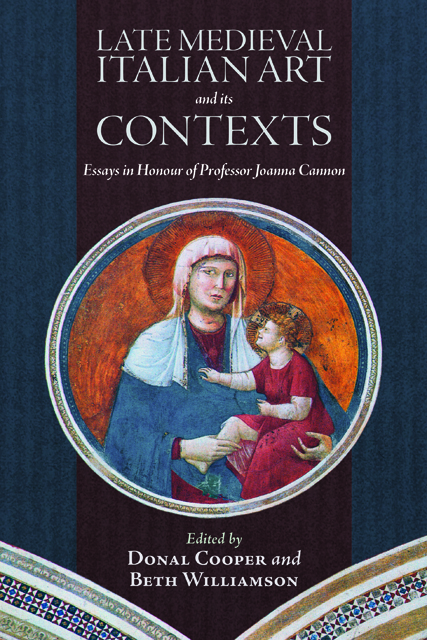Book contents
- Frontmatter
- Contents
- List of Illustrations
- List of Contributors
- Acknowledgements
- List of Abbreviations
- 1 Introduction: Circling Giotto
- 2 Holy Wood / ‘sacra tavola’: Saint Dominic and the Memory of Miracles in Bologna
- 3 The Sculpted Saint: A Statue of Saint Francis in Siena
- 4 Guccio di Mannaia and the Concept of a ‘Franciscan’ Chalice
- 5 ‘Speculum sine macula’: The Trittico di Santa Chiara in Trieste as an Object of Clarissan Devotion
- 6 The Siena Connection: A Franciscan Provincial Minister between Tuscany and Assisi at the Dawn of the Trecento
- 7 Simone Martini’s ‘Treaty with the House of Santa Fiora’ in Siena’s Palazzo Pubblico: Its Date and Significance
- 8 Crisis and Charity in Fourteenth-Century Florence: Ambrogio Lorenzetti’s Saint Nicholas Panels for San Procolo
- 9 Father of Light: Giotto and the Beatific Vision in the Baroncelli Chapel
- 10 Painter-Illuminator Workshops and the Church of San Giorgio a Ruballa: The Case of Bernardo Daddi and Pacino di Bonaguida
- 11 Patterns of Holiness: A Virgin Lactans in a Franciscan Context
- 12 A New Angle on Simone Martini’s Holy Family
- 13 Artistic Appropriation, Institutional Identity, and Civic Religion in Fourteenth-Century Siena: The Byzantine Treasury of the Hospital of Santa Maria della Scala
- 14 Visual Religious Education in Late Medieval Florence: Zanobi Perini, The Leggenda di Santo Tobia, and The Misericordia
- 15 Saints and Status in Late Medieval and Early Renaissance Florence
- Select Bibliography
- Publications by Joanna Cannon
- Index
- Tabula Gratulatoria
- Backmatter
8 - Crisis and Charity in Fourteenth-Century Florence: Ambrogio Lorenzetti’s Saint Nicholas Panels for San Procolo
Published online by Cambridge University Press: 20 December 2022
- Frontmatter
- Contents
- List of Illustrations
- List of Contributors
- Acknowledgements
- List of Abbreviations
- 1 Introduction: Circling Giotto
- 2 Holy Wood / ‘sacra tavola’: Saint Dominic and the Memory of Miracles in Bologna
- 3 The Sculpted Saint: A Statue of Saint Francis in Siena
- 4 Guccio di Mannaia and the Concept of a ‘Franciscan’ Chalice
- 5 ‘Speculum sine macula’: The Trittico di Santa Chiara in Trieste as an Object of Clarissan Devotion
- 6 The Siena Connection: A Franciscan Provincial Minister between Tuscany and Assisi at the Dawn of the Trecento
- 7 Simone Martini’s ‘Treaty with the House of Santa Fiora’ in Siena’s Palazzo Pubblico: Its Date and Significance
- 8 Crisis and Charity in Fourteenth-Century Florence: Ambrogio Lorenzetti’s Saint Nicholas Panels for San Procolo
- 9 Father of Light: Giotto and the Beatific Vision in the Baroncelli Chapel
- 10 Painter-Illuminator Workshops and the Church of San Giorgio a Ruballa: The Case of Bernardo Daddi and Pacino di Bonaguida
- 11 Patterns of Holiness: A Virgin Lactans in a Franciscan Context
- 12 A New Angle on Simone Martini’s Holy Family
- 13 Artistic Appropriation, Institutional Identity, and Civic Religion in Fourteenth-Century Siena: The Byzantine Treasury of the Hospital of Santa Maria della Scala
- 14 Visual Religious Education in Late Medieval Florence: Zanobi Perini, The Leggenda di Santo Tobia, and The Misericordia
- 15 Saints and Status in Late Medieval and Early Renaissance Florence
- Select Bibliography
- Publications by Joanna Cannon
- Index
- Tabula Gratulatoria
- Backmatter
Summary
The Sienese artist Ambrogio Lorenzetti created two works for the church of San Procolo in Florence. One of them, a triptych of the Virgin and Child flanked by the two bishop saints Nicholas and Proculus, once bore Ambrogio’s signature and the date 1332. The other – the subject of this essay – now consists of two panels, each depicting a pair of scenes from the life and miracles of Saint Nicholas of Bari (Plates X and XI). This quartet is one of the most sophisticated and best-known narrative ensembles from the Trecento, but its context in a modest parish church remains underexplored. By focusing on San Procolo, its institutional links, and its lay patrons, this essay will suggest that Lorenzetti’s narratives responded to their setting and likely audience within the church, spoke to the preoccupations of Florentines in the years around 1330, and expressed the concerns of their patron, who can be identified for the first time.
San Procolo is a small parish church in the ancient heart of Florence, just to the north-east of the Bargello, on the corner of Via de’ Giraldi and Via de’ Pandolfini. Probably already founded by the first millennium, in 1064 it was gifted by the Bishop of Florence to the nearby Benedictine monastery of Santa Maria, commonly known as the Badia Fiorentina. In 1622 the church was totally rebuilt and its orientation reversed, with the high altar being moved to the west end and the main door to the east; its interior was further remodelled in the eighteenth century. Consequently, the interior of the church gives no clues as to the original position or function of Ambrogio Lorenzetti’s panels. San Procolo remained under the control of the Badia until it was suppressed in 1778 and sold to Cardinal Salviati, in whose family’s possession it remains. At the time of writing, the church is deconsecrated and closed to the public. After San Procolo was secularised, the Saint Nicholas panels were transferred to the Badia. When that church, too, was suppressed, they entered the Galleria dell’Accademia before being transferred to the Uffizi in 1919.
- Type
- Chapter
- Information
- Late Medieval Italian Art and its ContextsEssays in Honour of Professor Joanna Cannon, pp. 133 - 158Publisher: Boydell & BrewerPrint publication year: 2022



